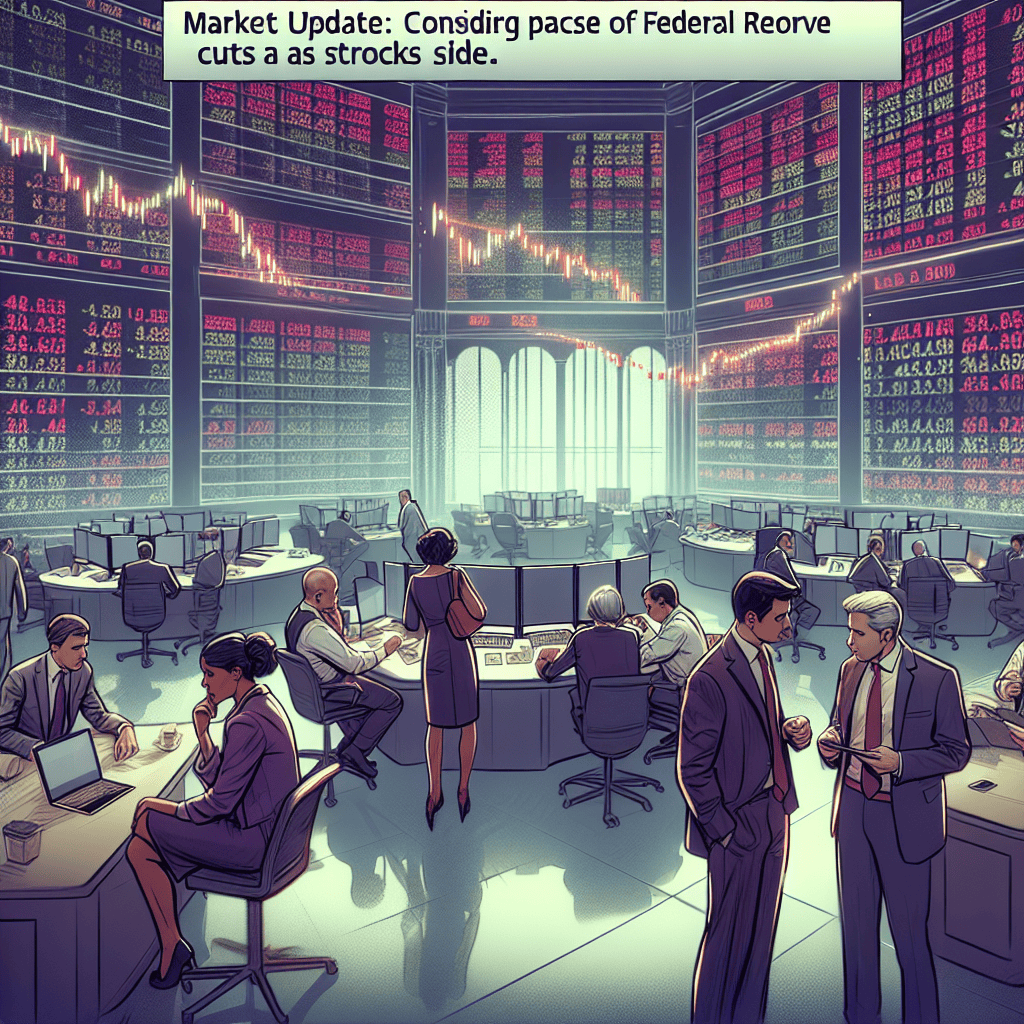“Wall Street Watches: Fed-Cut Decisions Amid Sliding Stocks”
Introduction
Wall Street is currently navigating a turbulent landscape as investors closely monitor the Federal Reserve’s potential adjustments to interest rate cuts amidst a backdrop of declining stock prices. The market’s recent downturn has intensified scrutiny on the Fed’s monetary policy decisions, with stakeholders weighing the pace and scale of potential rate reductions. This dynamic environment reflects broader economic uncertainties and the challenges faced by policymakers in balancing growth and stability. As stocks continue to slide, the financial community remains on edge, anticipating the Fed’s next moves and their implications for the market’s trajectory.
Impact Of Fed Rate Cuts On Wall Street Stocks
In recent months, Wall Street has been closely monitoring the Federal Reserve’s monetary policy decisions, particularly the pace at which it might cut interest rates. This scrutiny comes amid a backdrop of fluctuating stock prices and economic uncertainty. As investors seek to navigate these turbulent waters, understanding the impact of potential Fed rate cuts on Wall Street stocks becomes increasingly crucial.
The Federal Reserve’s interest rate decisions are pivotal in shaping the economic landscape, influencing borrowing costs, consumer spending, and ultimately, corporate profits. When the Fed opts to cut rates, it typically aims to stimulate economic activity by making borrowing cheaper, thereby encouraging businesses to invest and consumers to spend. This, in turn, can lead to higher corporate earnings, which often boosts stock prices. However, the relationship between rate cuts and stock market performance is not always straightforward.
In the current economic climate, characterized by concerns over inflation and geopolitical tensions, the prospect of rate cuts has been met with mixed reactions from investors. On one hand, lower interest rates can provide a much-needed boost to economic growth, potentially alleviating some of the pressures that have weighed on corporate earnings. On the other hand, the reasons behind the Fed’s decision to cut rates—such as slowing economic growth or persistent inflation—can also signal underlying weaknesses in the economy, which may dampen investor sentiment.
Moreover, the pace at which the Fed decides to implement rate cuts is a critical factor that Wall Street is weighing. A gradual approach might suggest that the Fed is cautiously optimistic about the economy’s resilience, providing a steady hand to guide markets through uncertainty. Conversely, a more aggressive series of cuts could indicate heightened concerns about economic stability, potentially leading to increased volatility in stock markets.
As stocks continue to slide, investors are left to ponder the implications of the Fed’s potential actions. Some sectors may benefit more than others from rate cuts. For instance, interest rate-sensitive sectors such as real estate and utilities might experience a boost, as lower borrowing costs can enhance profitability. Conversely, financial institutions, which often rely on higher interest rates to maintain profit margins, might face challenges in a low-rate environment.
Furthermore, the global context cannot be ignored. As central banks around the world also adjust their monetary policies in response to economic conditions, the interplay between domestic and international factors adds another layer of complexity to the equation. Investors must consider how global economic trends and foreign central bank actions might influence the effectiveness of the Fed’s rate cuts on U.S. markets.
In conclusion, as Wall Street grapples with the potential impact of Fed rate cuts, investors are tasked with balancing optimism for economic stimulus against caution over the reasons necessitating such measures. The pace and scale of these cuts will undoubtedly play a significant role in shaping market dynamics in the coming months. As such, staying informed and adaptable will be key for investors seeking to navigate the evolving landscape of Wall Street stocks. By closely monitoring economic indicators and Fed communications, market participants can better position themselves to respond to the challenges and opportunities that lie ahead.
Analyzing The Recent Stock Market Slide
In recent weeks, Wall Street has been closely monitoring the Federal Reserve’s monetary policy decisions, particularly the pace at which it might cut interest rates. This scrutiny comes amid a notable slide in stock prices, prompting investors and analysts to reassess their strategies and expectations. The interplay between the Federal Reserve’s actions and market performance is a complex dynamic, influenced by a myriad of economic indicators and investor sentiment.
The Federal Reserve’s role in shaping economic conditions cannot be overstated. By adjusting interest rates, the Fed influences borrowing costs, consumer spending, and business investment. In periods of economic uncertainty or slowdown, the Fed may opt to cut rates to stimulate growth. However, the timing and magnitude of these cuts are critical. A more aggressive approach might signal deeper economic concerns, while a cautious pace could suggest confidence in the economy’s resilience. Consequently, Wall Street’s focus on the Fed’s decisions is both a reflection of current market conditions and a predictor of future trends.
As stocks have recently experienced a downturn, investors are keenly aware of the potential implications of the Fed’s actions. The slide in stock prices can be attributed to several factors, including geopolitical tensions, supply chain disruptions, and inflationary pressures. These elements have created a challenging environment for businesses, leading to reduced earnings forecasts and increased market volatility. In this context, the Fed’s monetary policy becomes a crucial tool for stabilizing the economy and restoring investor confidence.
Moreover, the relationship between interest rates and stock market performance is multifaceted. Lower interest rates generally make borrowing cheaper, encouraging businesses to invest and expand. This can lead to higher corporate earnings and, subsequently, rising stock prices. However, if rate cuts are perceived as a response to severe economic distress, they may not have the desired effect on market sentiment. Investors may interpret such moves as a sign of underlying weaknesses, leading to further sell-offs.
In addition to the Fed’s actions, other economic indicators play a significant role in shaping market dynamics. Employment data, consumer confidence, and corporate earnings reports are all closely watched by market participants. Positive developments in these areas can offset some of the negative impacts of external pressures, providing a more balanced outlook for the economy. Conversely, disappointing data can exacerbate market declines, reinforcing the need for careful analysis and strategic decision-making.
As Wall Street navigates this period of uncertainty, the importance of clear communication from the Federal Reserve cannot be overstated. Investors rely on guidance from the Fed to make informed decisions, and any ambiguity can lead to increased volatility. Therefore, transparency and consistency in messaging are essential to maintaining market stability.
In conclusion, the recent slide in stock prices has underscored the critical role of the Federal Reserve in influencing market conditions. As Wall Street weighs the pace of potential rate cuts, the interplay between economic indicators, investor sentiment, and monetary policy will continue to shape the financial landscape. By closely monitoring these factors, investors can better position themselves to navigate the challenges and opportunities that lie ahead.
Investor Reactions To Fed’s Monetary Policy
In recent weeks, Wall Street has been closely monitoring the Federal Reserve’s monetary policy decisions, particularly the pace at which interest rate cuts are being implemented. This scrutiny comes amid a backdrop of fluctuating stock markets, where investors are grappling with the implications of these policy shifts. As stocks continue to slide, the focus has intensified on how the Federal Reserve’s actions might influence market dynamics and investor sentiment.
The Federal Reserve’s monetary policy is a critical factor in shaping economic conditions, and its decisions on interest rates are particularly influential. Lowering interest rates is typically intended to stimulate economic activity by making borrowing cheaper, thereby encouraging spending and investment. However, the timing and magnitude of these cuts are crucial, as they can have varying effects on different sectors of the economy. Investors are keenly aware that a misstep in the pace of rate cuts could either fail to provide the necessary economic boost or, conversely, lead to overheating and inflationary pressures.
As the Federal Reserve navigates this delicate balance, investors are reacting with a mix of caution and anticipation. The recent slide in stock prices reflects a degree of uncertainty about the future trajectory of monetary policy. Market participants are weighing the potential benefits of rate cuts against the risks of an economic slowdown, which could be exacerbated by external factors such as geopolitical tensions and trade disputes. This uncertainty is prompting investors to reassess their portfolios, often leading to increased volatility in the stock market.
Moreover, the Federal Reserve’s communication strategy plays a pivotal role in shaping investor expectations. Clear and consistent messaging can help mitigate market volatility by providing investors with a better understanding of the central bank’s policy intentions. However, any perceived ambiguity or inconsistency in the Fed’s statements can lead to heightened market anxiety, as investors attempt to decipher the implications for future economic conditions. Consequently, the Federal Reserve’s ability to effectively communicate its policy stance is as important as the policy actions themselves.
In addition to domestic considerations, global economic conditions are also influencing investor reactions to the Federal Reserve’s monetary policy. The interconnectedness of global markets means that developments in other major economies can have significant repercussions for U.S. markets. For instance, economic slowdowns in Europe or Asia could dampen global demand, thereby affecting U.S. exports and corporate earnings. Investors are therefore closely monitoring international economic indicators, as these can provide valuable insights into the potential impact on U.S. markets.
As Wall Street continues to weigh the pace of Fed rate cuts, it is clear that investor reactions are shaped by a complex interplay of factors. The Federal Reserve’s policy decisions, communication strategies, and global economic conditions all contribute to the evolving market landscape. While the current environment presents challenges, it also offers opportunities for investors who are able to navigate the uncertainties and adapt their strategies accordingly. Ultimately, the ability to anticipate and respond to changes in monetary policy will be crucial for investors seeking to achieve their financial objectives in this dynamic market environment.
Historical Trends: Fed Cuts And Stock Market Performance

The relationship between Federal Reserve interest rate cuts and stock market performance has long been a subject of keen interest among investors and economists alike. Historically, the Federal Reserve’s monetary policy decisions, particularly regarding interest rate adjustments, have had significant implications for the stock market. As Wall Street currently grapples with the pace of potential Fed cuts amidst a sliding stock market, it is instructive to examine historical trends to better understand the potential outcomes of such monetary policy actions.
In the past, the Federal Reserve has often resorted to cutting interest rates during periods of economic slowdown or financial instability. These rate cuts are typically intended to stimulate economic activity by making borrowing cheaper, thereby encouraging spending and investment. For instance, during the financial crisis of 2008, the Fed aggressively slashed interest rates to near-zero levels in an effort to stabilize the economy. This move was followed by a significant rebound in the stock market, as lower interest rates made equities more attractive compared to fixed-income securities.
However, the relationship between Fed cuts and stock market performance is not always straightforward. While rate cuts can provide a boost to the stock market, they are often implemented in response to underlying economic weaknesses, which can weigh on investor sentiment. For example, during the early 2000s, the Fed cut rates multiple times in response to the bursting of the dot-com bubble and the subsequent economic downturn. Although these cuts eventually helped to stabilize the economy, the stock market experienced considerable volatility and took several years to fully recover.
Moreover, the timing and magnitude of rate cuts can also influence their effectiveness. A gradual approach to cutting rates may provide a more sustained boost to the stock market, as it allows investors to adjust their expectations and strategies accordingly. Conversely, rapid and aggressive rate cuts might signal to investors that the economic situation is more dire than previously thought, potentially leading to increased market volatility. This delicate balance underscores the importance of clear communication from the Federal Reserve regarding its policy intentions and economic outlook.
In the current context, as Wall Street weighs the pace of potential Fed cuts, it is crucial to consider both the historical precedents and the unique circumstances of today’s economic environment. The ongoing challenges posed by global economic uncertainties, inflationary pressures, and geopolitical tensions add layers of complexity to the Fed’s decision-making process. Investors must therefore remain vigilant and adaptable, as the interplay between monetary policy and market dynamics continues to evolve.
Furthermore, it is essential to recognize that while Fed cuts can influence stock market performance, they are just one of many factors that investors must consider. Corporate earnings, economic data releases, and broader market trends all play critical roles in shaping investor sentiment and market movements. As such, a comprehensive approach that takes into account both monetary policy and other relevant factors is necessary for making informed investment decisions.
In conclusion, the historical trends of Fed cuts and stock market performance provide valuable insights into the potential impacts of monetary policy on financial markets. While past experiences offer guidance, the unique challenges of the present day require careful analysis and strategic foresight. As Wall Street navigates the current landscape, understanding the nuances of Fed policy and its implications for the stock market will be key to successfully managing risk and capitalizing on opportunities.
Strategies For Investors During Market Volatility
In the ever-evolving landscape of financial markets, investors are constantly seeking strategies to navigate periods of volatility. The recent slide in stock prices, coupled with Wall Street’s anticipation of the Federal Reserve’s pace in cutting interest rates, has underscored the importance of having a well-thought-out approach during uncertain times. As market participants weigh the potential implications of monetary policy adjustments, it becomes crucial for investors to adopt strategies that not only mitigate risks but also capitalize on emerging opportunities.
To begin with, diversification remains a cornerstone strategy for managing market volatility. By spreading investments across various asset classes, sectors, and geographic regions, investors can reduce the impact of adverse movements in any single area. This approach helps in balancing the portfolio, as gains in one segment can offset losses in another. Moreover, diversification allows investors to participate in different growth stories, thereby enhancing the potential for long-term returns.
In addition to diversification, maintaining a focus on high-quality assets is essential. During periods of market turbulence, companies with strong balance sheets, robust cash flows, and competitive advantages tend to be more resilient. These firms are better positioned to weather economic downturns and emerge stronger when conditions improve. Consequently, investors should prioritize quality over speculative opportunities, ensuring that their portfolios are anchored by fundamentally sound investments.
Furthermore, adopting a long-term perspective can be particularly beneficial during volatile times. Market fluctuations, while unsettling, are a natural part of the investment landscape. By maintaining a focus on long-term goals and resisting the urge to make impulsive decisions based on short-term market movements, investors can avoid the pitfalls of emotional trading. This disciplined approach not only helps in preserving capital but also allows investors to take advantage of attractive valuations when markets overreact to temporary setbacks.
Another strategy that can prove advantageous is the use of dollar-cost averaging. This technique involves investing a fixed amount of money at regular intervals, regardless of market conditions. By doing so, investors can reduce the impact of market timing and benefit from the compounding effect over time. Dollar-cost averaging ensures that more shares are purchased when prices are low and fewer when prices are high, ultimately leading to a lower average cost per share.
Moreover, staying informed about macroeconomic trends and central bank policies is crucial for making informed investment decisions. As Wall Street closely monitors the Federal Reserve’s actions, understanding the potential impact of interest rate changes on different asset classes can provide valuable insights. For instance, lower interest rates generally benefit equities and real estate, while higher rates may favor fixed-income securities. By aligning investment strategies with the prevailing economic environment, investors can better position themselves to capitalize on opportunities and manage risks.
In conclusion, navigating market volatility requires a combination of strategic planning, disciplined execution, and informed decision-making. By diversifying portfolios, focusing on quality assets, maintaining a long-term perspective, employing dollar-cost averaging, and staying attuned to macroeconomic developments, investors can effectively manage the challenges posed by uncertain market conditions. As Wall Street continues to weigh the pace of Fed rate cuts and their implications for financial markets, these strategies can serve as a robust framework for achieving investment objectives amidst volatility.
The Role Of Federal Reserve In Economic Stability
The Federal Reserve plays a pivotal role in maintaining economic stability, a responsibility that becomes particularly pronounced during periods of market volatility. As Wall Street grapples with the recent slide in stock prices, investors and analysts alike are closely scrutinizing the pace at which the Federal Reserve might adjust interest rates. This scrutiny is not without reason, as the central bank’s monetary policy decisions have far-reaching implications for both the financial markets and the broader economy.
To understand the current market dynamics, it is essential to consider the context in which the Federal Reserve operates. The central bank’s primary objectives are to promote maximum employment, stabilize prices, and moderate long-term interest rates. In pursuit of these goals, the Federal Reserve employs a range of tools, with the federal funds rate being one of the most influential. By adjusting this rate, the Fed can influence borrowing costs, consumer spending, and ultimately, economic growth.
In recent months, the Federal Reserve has been navigating a complex economic landscape characterized by persistent inflationary pressures and uneven economic recovery. As inflation rates have remained above the Fed’s target, there has been considerable debate about the appropriate pace of interest rate cuts. On one hand, a more aggressive approach to cutting rates could stimulate economic activity by making borrowing cheaper for businesses and consumers. On the other hand, a cautious approach might be warranted to prevent exacerbating inflationary trends.
The stock market’s recent downturn has added another layer of complexity to this decision-making process. As stock prices have slid, concerns about the potential for a broader economic slowdown have intensified. In this environment, the Federal Reserve’s actions are being closely monitored for signals about its future policy direction. Investors are particularly interested in whether the Fed will prioritize supporting economic growth or curbing inflation, as this decision will have significant implications for asset prices.
Moreover, the global economic context cannot be ignored. The interconnectedness of global financial markets means that the Federal Reserve’s decisions are not made in isolation. Economic developments in other major economies, such as Europe and China, can influence the Fed’s policy choices. For instance, if other central banks adopt more accommodative monetary policies, the Fed might face pressure to follow suit to maintain competitive interest rates and prevent capital outflows.
In light of these considerations, the Federal Reserve’s communication strategy becomes crucial. Clear and transparent communication can help manage market expectations and reduce uncertainty. By providing guidance on its policy outlook, the Fed can help stabilize financial markets and support economic confidence. However, striking the right balance in communication is challenging, as overly hawkish or dovish signals can lead to unintended market reactions.
As Wall Street continues to weigh the potential pace of Fed rate cuts, the central bank’s role in ensuring economic stability remains as critical as ever. The decisions made by the Federal Reserve in the coming months will not only shape the trajectory of the U.S. economy but also influence global financial markets. In this context, the Fed’s ability to navigate the delicate balance between fostering growth and controlling inflation will be a key determinant of economic stability in the near term. As such, all eyes remain on the Federal Reserve as it charts a course through these uncertain economic waters.
Future Projections: Wall Street’s Response To Fed Decisions
As Wall Street navigates the complexities of the current economic landscape, the focus has increasingly shifted towards the Federal Reserve’s monetary policy decisions, particularly the pace at which interest rate cuts might be implemented. This scrutiny comes amid a backdrop of sliding stock prices, which have prompted investors to reassess their strategies and expectations for the future. The interplay between Federal Reserve actions and market responses is a critical dynamic that continues to shape the financial environment.
In recent months, the Federal Reserve has signaled a more accommodative stance, suggesting potential rate cuts to support economic growth. This shift is largely in response to a confluence of factors, including global economic uncertainties, trade tensions, and subdued inflationary pressures. As a result, market participants are keenly observing the Fed’s communications and policy decisions, attempting to gauge the trajectory of future rate adjustments. The anticipation of these cuts has already influenced market behavior, with investors recalibrating their portfolios to align with the expected lower interest rate environment.
However, the pace at which the Federal Reserve might implement these cuts remains a subject of intense debate. Some analysts argue for a more aggressive approach, advocating for swift and significant reductions to preemptively counteract potential economic slowdowns. Others, however, caution against hasty actions, suggesting that a more measured pace would allow for a careful assessment of economic indicators and the impact of previous rate changes. This divergence in perspectives underscores the complexity of the Fed’s decision-making process and its implications for financial markets.
As stocks continue to slide, the pressure on the Federal Reserve to act decisively has intensified. The recent downturn in equity markets reflects a broader sentiment of uncertainty and risk aversion among investors. Concerns about slowing global growth, geopolitical tensions, and the potential for a protracted trade war have all contributed to this cautious outlook. In this context, the Fed’s policy decisions are seen as a critical lever to restore confidence and stability in the markets.
Moreover, the relationship between interest rates and stock market performance is multifaceted. While lower interest rates generally support higher stock valuations by reducing borrowing costs and encouraging investment, they can also signal underlying economic weaknesses that may weigh on corporate earnings and growth prospects. Consequently, the timing and magnitude of rate cuts are crucial in determining their overall impact on market sentiment and investor behavior.
Looking ahead, Wall Street’s response to the Federal Reserve’s decisions will likely hinge on a combination of factors, including the clarity of the Fed’s communication, the alignment of its actions with market expectations, and the broader economic context. Investors will be closely monitoring upcoming economic data releases, Fed meeting minutes, and public statements from key policymakers to glean insights into the central bank’s future course of action.
In conclusion, as Wall Street weighs the pace of potential Fed rate cuts amid a backdrop of sliding stocks, the interplay between monetary policy and market dynamics remains a focal point for investors. The Federal Reserve’s decisions will undoubtedly have far-reaching implications, influencing not only the trajectory of financial markets but also the broader economic landscape. As such, maintaining a keen awareness of these developments will be essential for market participants seeking to navigate the challenges and opportunities that lie ahead.
Q&A
1. **What is the main focus of the Wall Street market update?**
– The main focus is on how Wall Street is assessing the pace at which the Federal Reserve might cut interest rates amid a decline in stock prices.
2. **Why are stocks sliding in this market update?**
– Stocks are sliding due to concerns about economic growth, inflation, and the potential impact of Federal Reserve policies on the market.
3. **How is the Federal Reserve’s interest rate policy affecting investor sentiment?**
– Investor sentiment is affected by uncertainty over how quickly the Federal Reserve will cut interest rates, which influences market stability and economic outlook.
4. **What sectors are most impacted by the stock slide?**
– Typically, interest rate-sensitive sectors such as technology, real estate, and financials are most impacted by changes in Federal Reserve policy and stock market volatility.
5. **What are analysts predicting about future Federal Reserve actions?**
– Analysts are predicting a cautious approach by the Federal Reserve, with potential gradual rate cuts depending on economic indicators and inflation trends.
6. **How are bond markets reacting to the potential Fed rate cuts?**
– Bond markets may see increased demand, leading to lower yields, as investors seek safer assets amid uncertainty about future interest rate cuts.
7. **What strategies are investors considering in response to the current market conditions?**
– Investors might consider diversifying portfolios, increasing cash reserves, or shifting towards defensive stocks to mitigate risks associated with market volatility and interest rate changes.
Conclusion
The recent market update highlights growing concerns on Wall Street regarding the pace at which the Federal Reserve might cut interest rates, as evidenced by the decline in stock prices. Investors are increasingly wary of the economic outlook and the Fed’s monetary policy decisions, which are seen as critical to stabilizing markets and supporting growth. The slide in stocks reflects uncertainty and a cautious approach by market participants, who are closely monitoring economic indicators and Fed communications for clearer guidance. This environment underscores the delicate balance the Fed must maintain in its policy actions to foster economic stability while addressing inflationary pressures.





